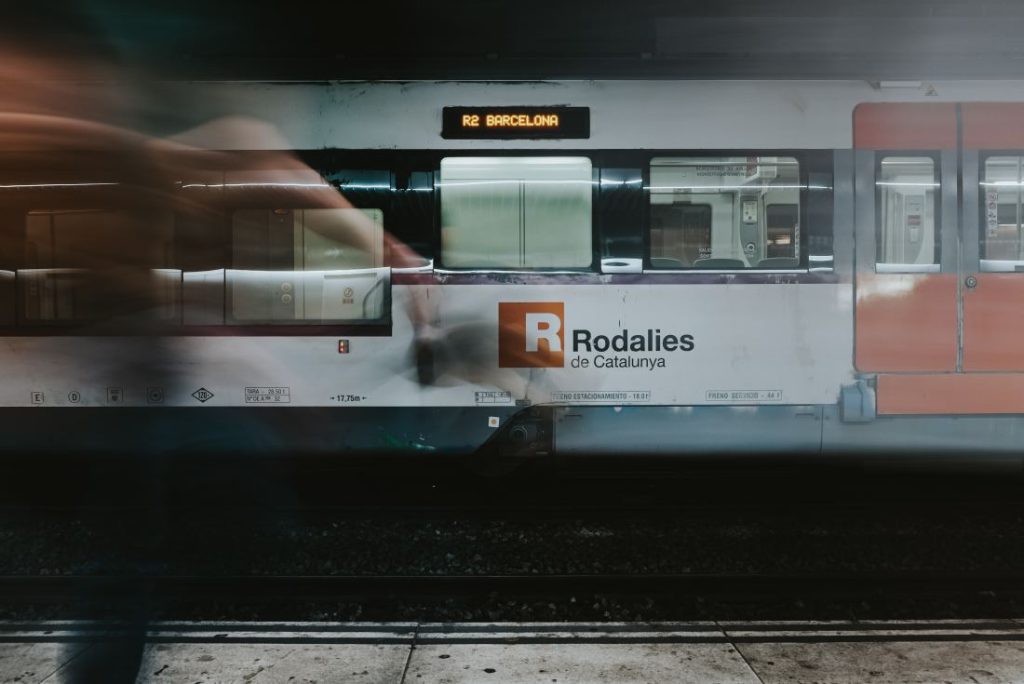Barcelona is one of the most beautiful cities in the world, thanks to its Catalan style, excellent weather, seaside location, and of course, its sights. It’s also one of my favorites!
Spain’s second-largest city is situated on the Mediterranean coast, south of the Pyrenees and the French border. Its football team, FC Barcelona, is one of the most famous and popular clubs in the world.
Table of Contents
Barcelona attractions
La Sagrada Familia
One of the most famous churches in the world, it is expected to be completed by 2026. In 2010, the Pope consecrated the Church of the Holy Family as a basilica.
Its interesting appearance is a true architectural masterpiece. It’s worth seeing even for those who do not want to visit churches. You can go up to two of its towers, both offering beautiful views of the city.
The construction of the church was the idea of a local bookseller, and much of the work was overseen by the famous architect Antoni Gaudi. He dedicated the end of his life to the construction of the Sagrada Familia. He is buried in the crypt of the church.
All information (ticket prices, opening hours, etc.) can be found here!
Access: take metro lines 1 or 5 to the Sagrada Familia stop.
Sagrada Família – The unique artistic wonder
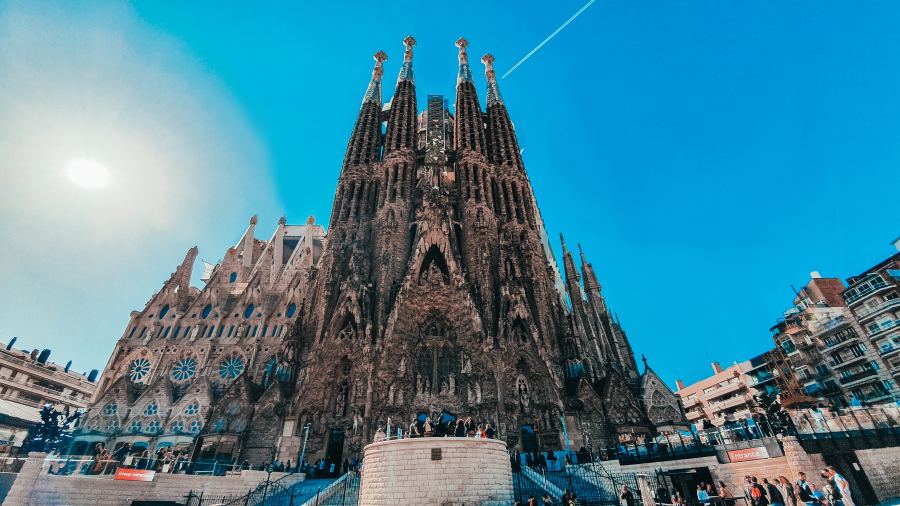
Park Güell
Gaudi’s other futuristic work besides the Sagrada Familia. The park features gaudy buildings and sculptures, and Gaudi himself lived here.
The park was built between 1900 and 1914 and officially opened as a public park in 1926. In 1984, UNESCO declared it a World Heritage Site under the category „Works of Gaudi”.
The park also offers great views of the city, and the unique creations make it worth entering. Famous are the two „gingerbread houses” at the entrance and the lizard statue next to the staircase.
It’s recommended to buy your ticket online in advance, as it is a very popular place and tickets are often not available on-site!
Information and ticket purchase can be found here!
Access: take bus 116 from the Juanic metro station to the Park Güell stop.
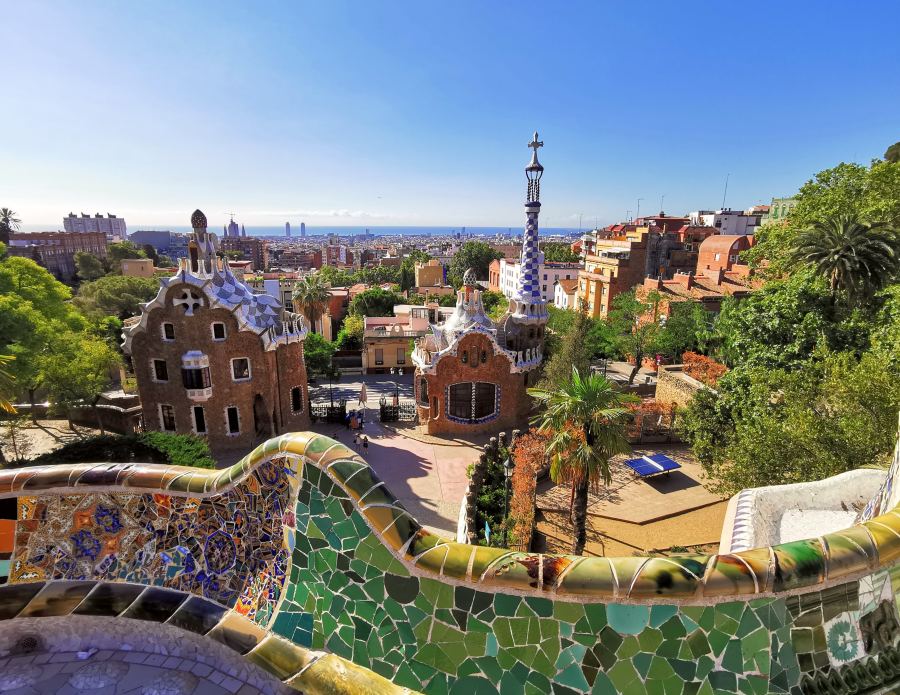
Cathedral (Catedral de Barcelona)
Located in the city center, the Gothic cathedral is where you can see the Catalan dance called Sardana on Sundays at noon.
Construction began in 1298 and lasted for over 150 years, completing in the mid-15th century. The cathedral is dedicated to Saint Eulalia, one of Barcelona’s patron saints, and houses her remains.
There are free visiting periods; information can be found here!
Access: take metro line 4 to Jaume I stop.
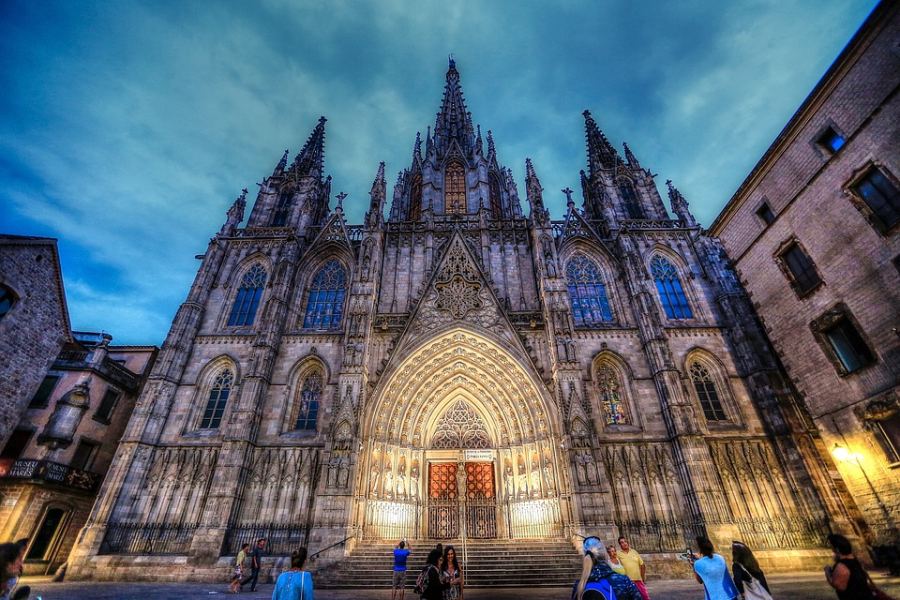
Santa Maria del Mar Cathedral
Not far from the Cathedral, in the El Born district, this Gothic church is equally impressive.
Its interior is adorned with tall, colorful stained glass windows that create beautiful light effects. Another special feature is that it was built by the members of the community themselves, which also played a significant role in the city’s history.
Access: take metro line 4 to Jaume I stop.
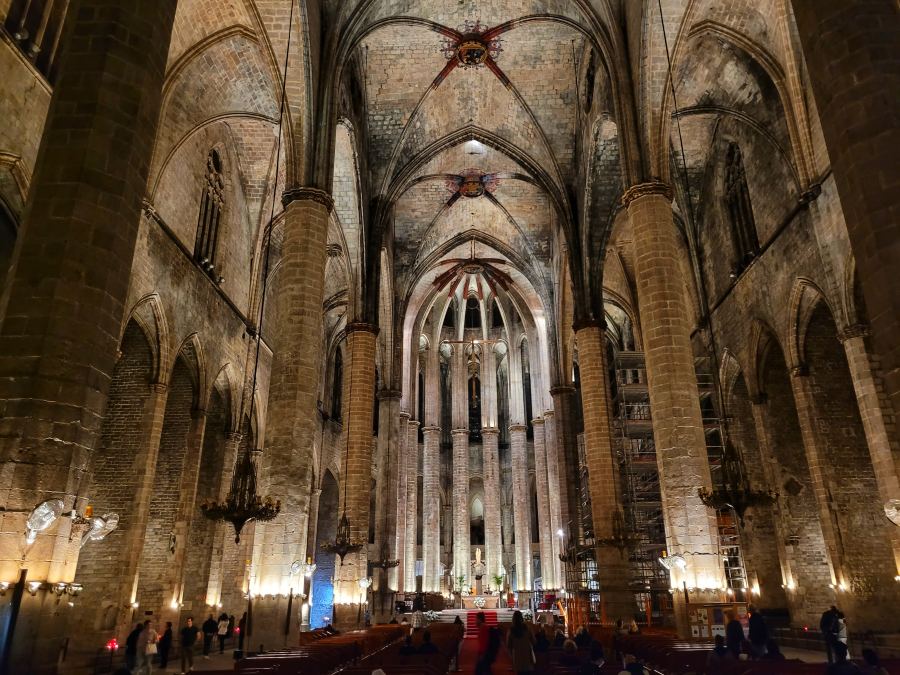
La Rambla
The 1300-meter-long pedestrian street is world-famous, stretching between Placa Catalunya square and the seaside.
You can see many vendors and performers here; it’s a must-see attraction in Barcelona. From the street, many small streets and alleys branch off; it’s worth wandering here during the day.

Palau Güell
Located on a street branching off from La Rambla, this Gaudi building was designed for the Catalan count, Eusebi Güell.
What makes the building remarkable is that a mansion had to be created in a small space, which was successfully accomplished. From the stables in the basement to the spacious main floor where Eusebi Güell and his family lived, the building is full of uniquely designed rooms.
One of the most notable parts of the building is the roof, where Gaudi used his famous „trencadís” technique, creating colorful chimneys from broken tile and ceramic pieces, which have become iconic elements of the Barcelona skyline. There are great views from here.
All information (ticket prices, opening hours, etc.) can be found here!

Placa Reial
Also accessed via an alley off La Rambla, the Royal Square features numerous restaurants and bars, and the square is enlivened by palm trees and a fountain.
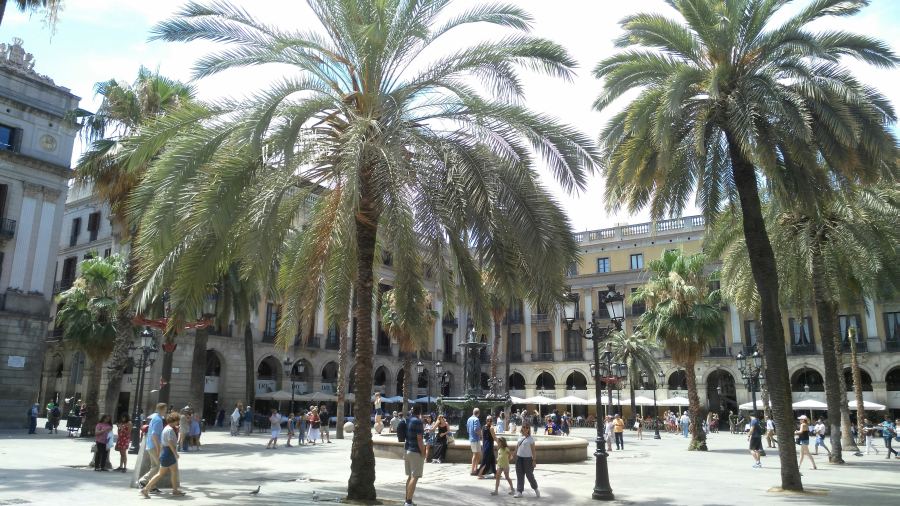
Columbus Monument
At the seaside end of La Rambla stands the statue, accessible by an elevator, offering a beautiful view from the top.
Tickets can be purchased online at a lower price.
Access: take metro line 3 to the Drassanes stop.

La Boqueria
This large market is located on the La Rambla pedestrian street. It’s definitely worth entering for the fantastic food and drinks available. Closed on Sundays!
Access: take metro line 3 to the Liceu stop.

Santa Caterina Market (Mercat de Santa Caterina)
Another great market, but much more authentic. Locals shop here, and you can find plenty of meat and seafood.
Access: take metro line 4 to the Jaume I stop, then walk 300 meters.
Casa Milà
Also known as La Pedrera (The Quarry), it is one of Antoni Gaudi’s most famous residential buildings.
The building practically summarizes his life’s work: here he most perfectly realizes the fusion of nature and architecture. It looks like a rugged, cave-riddled mountain.
Night visits are possible, offering a spectacular view of the illuminated city center from the roof.
All information (ticket prices, opening hours, etc.) can be found here!
Access: take metro lines 3 or 5 to the Diagonal stop.
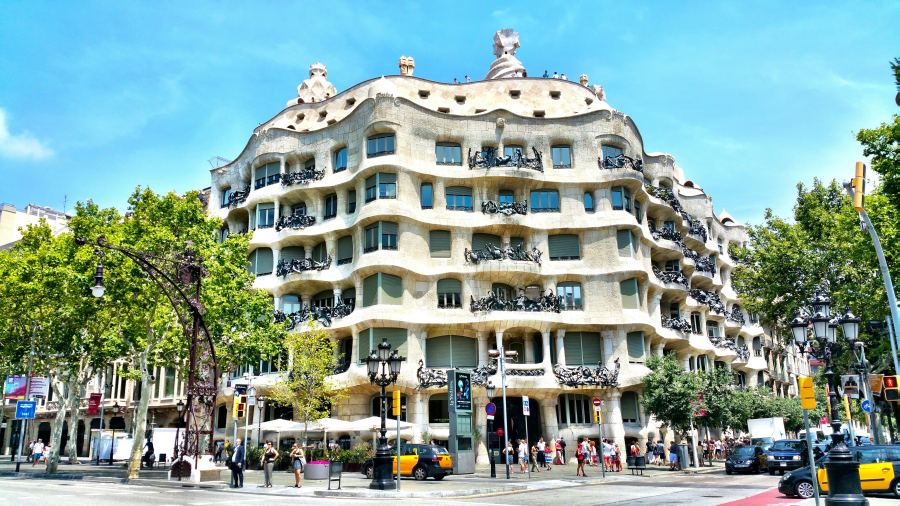
Casa Batlló
Known as the House of Bones, it was built for a middle-class family between 1904 and 1906.
Gaudi essentially transformed an existing residential building, keeping its structure intact while redesigning the balconies and adding a new roof and floors.
Inside, there are no straight lines or sharp edges, only organic forms. Casa Batlló is one of the most harmonious examples of Gaudi’s Art Nouveau style.
All information (ticket prices, opening hours, etc.) can be found here!
Access: take metro lines 2, 3, or 4 to the Passeig de Gracia stop.
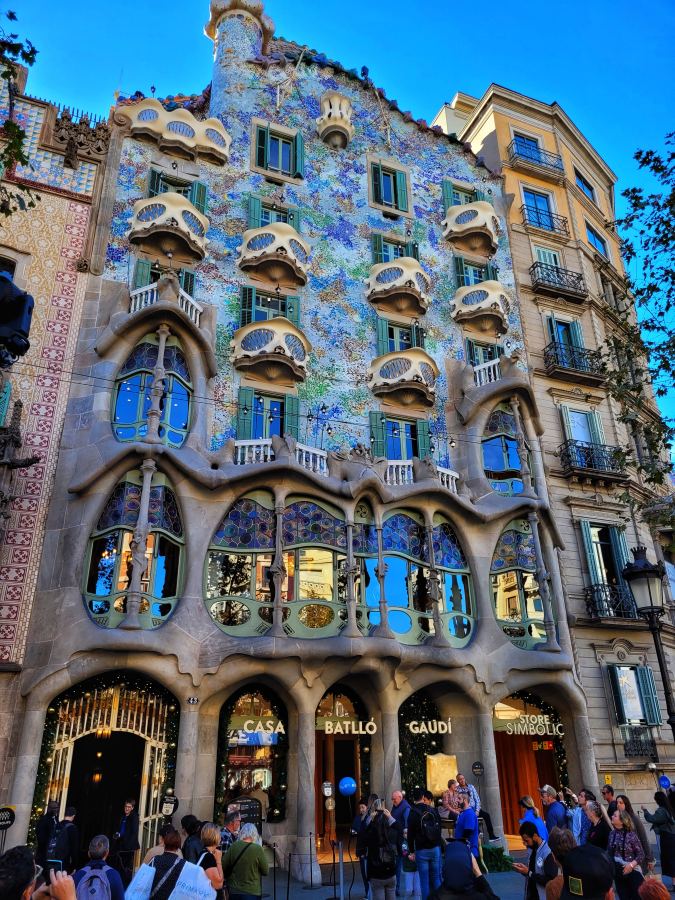
Casa Amatller
The building next to Casa Batlló is less visited but equally stunning inside and out.
It was designed by Josep Puig i Cadafalch for the industrialist and chocolatier Antoni Amatller, with construction taking place between 1898 and 1900.
After Amatller’s death in 1910, the house remained the home of his daughter until her death in 1960. Due to continuous ownership by the Amatller family, the house’s interior furnishings from the 1900s have been preserved to this day.
Casa Amatller is one of the key examples of Catalan Modernism, combining Gothic and Flemish architectural elements.
The walls and ceilings are decorated with frescoes, mosaics, and carvings depicting various themes such as family and industry. The ceilings in several rooms feature beautiful patterns. It’s worth looking up in every room.
The house can be visited with a tour guide. All information is available on the official website!
Casa Vicens
Gaudi’s magical early masterpiece, blending Mediterranean lifestyle with the bold lines of Catalan Modernism.
Built between 1883 and 1888, it was commissioned by Manuel Vicens i Montaner, a wealthy tile manufacturer. Vicens had a dual purpose for the house: as a residence and to showcase the unique azulejo products from his factory.
This building displays the architectural concepts that Gaudi would later adopt, such as the exaggeration of colors and the representation of plant motifs, particularly evident in the interiors.
All information (ticket prices, opening hours, etc.) can be found here!
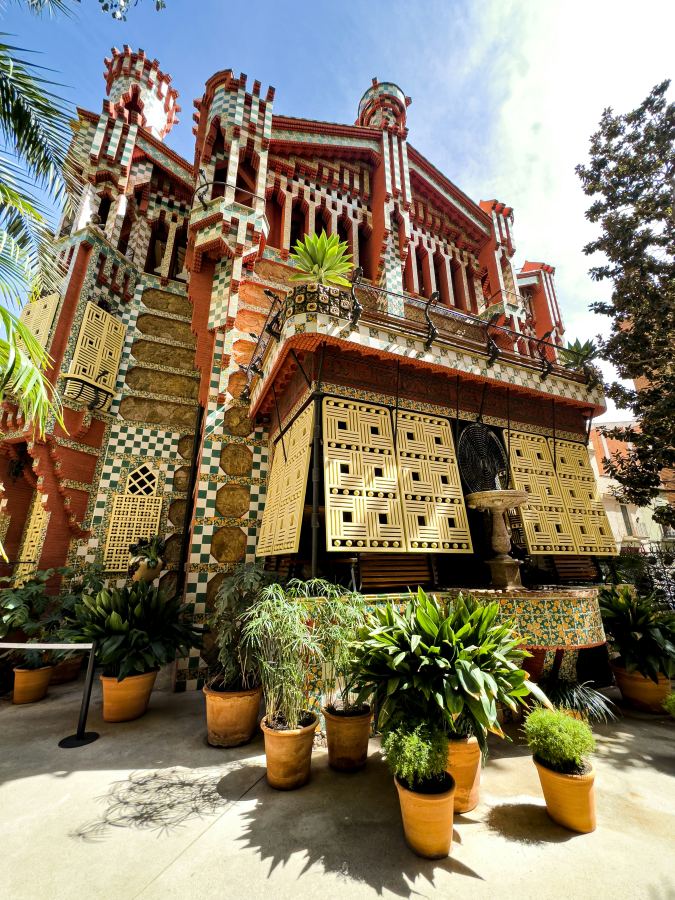
Recinte Modernista de Sant Pau
One of Barcelona’s most significant Modernist monuments, listed as a UNESCO World Heritage site.
Originally functioned as a hospital, and was one of the oldest healthcare institutions in the world. Its uniqueness lies in its architectural style. The complex consists of several pavilions, each richly decorated with tiles, sculptures, and stained glass windows.
A large room is set up as an old hospital room, allowing visitors to see what such an institution looked like in the past.
All information (ticket prices, opening hours, etc.) can be found here!
Access: take metro line 5 to the Sant Pau | Dos de Maig stop.
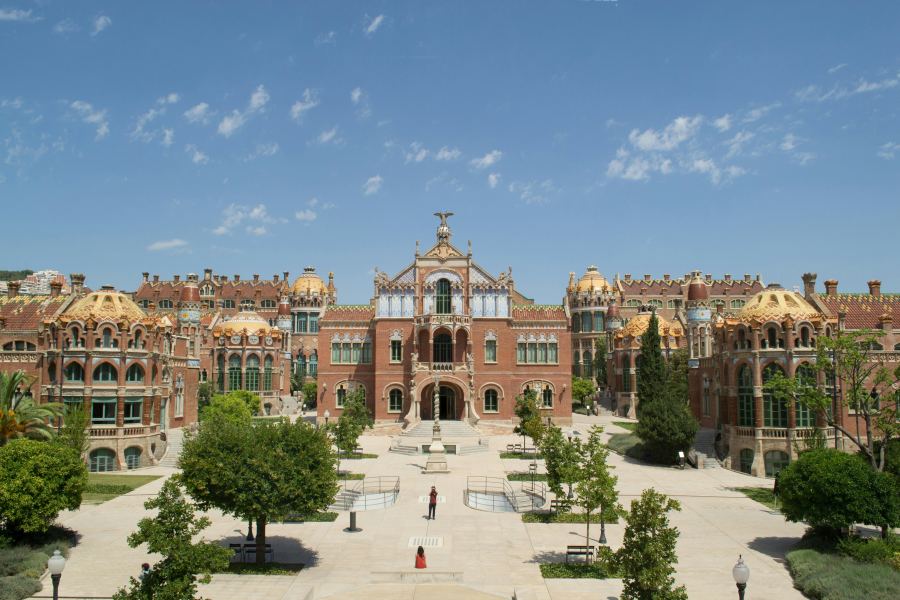
Aquarium
Located in the seaside area, not far from La Rambla, Barcelona’s aquarium is the largest in Europe.
Its special feature is an 80-meter-long underwater tunnel where rays, sharks, and numerous other species swim above the heads of visitors in six million liters of water.
All information (ticket prices, opening hours, etc.) can be found here!
Access: take bus V17 to the Port Vell stop.
Parc de la Ciutadella
Barcelona’s most famous park houses several attractions: the Catalan Parliament, a zoo, and the Natural History Museum.
Its most beautiful part is the Cascada Monumental fountain, topped with winged lions and horse-drawn carriages, with fiery dragons emerging below.
The park is filled with orange, magnolia, and oleander trees, and many parrots can be seen.
Access: take metro line 4 to the Ciutadella/Vila Olimpica stop.

Arc de Triomf
A few minutes’ walk from Parc de la Ciutadella along a palm-lined promenade stands this triumphal arch.
Unlike other triumphal arches, this one was not erected to celebrate a military victory but to honor the arts and sciences.
Access: take metro line 1 to the Arc de Triomf stop.
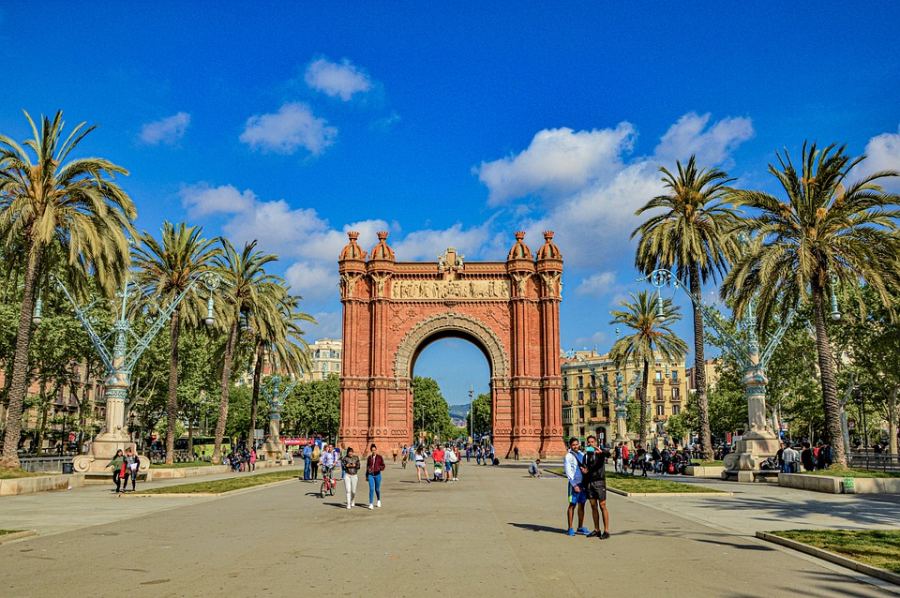
Terrace of Catalan National Museum
The terrace in front of Barcelona’s most significant museum offers a great view, making it a must-visit.
You can reach it via the steps next to the Font Magica de Montjuic fountain, and the panorama is worth the climb.
Access: a 350-meter walk from Espanya metro station.

Montjuic Castle (Castell de Montjuic)
The castle on top of Montjuic hill offers one of the best viewpoints in the city.
Originally built for defensive purposes to oversee the city and harbor, in the 20th century, the castle was used as a military prison and execution site during the Spanish Civil War.
The building itself may not offer much, but many visit for the views from the castle walls.
All information can be found here!
Access: take bus 150 from Espanya metro station.
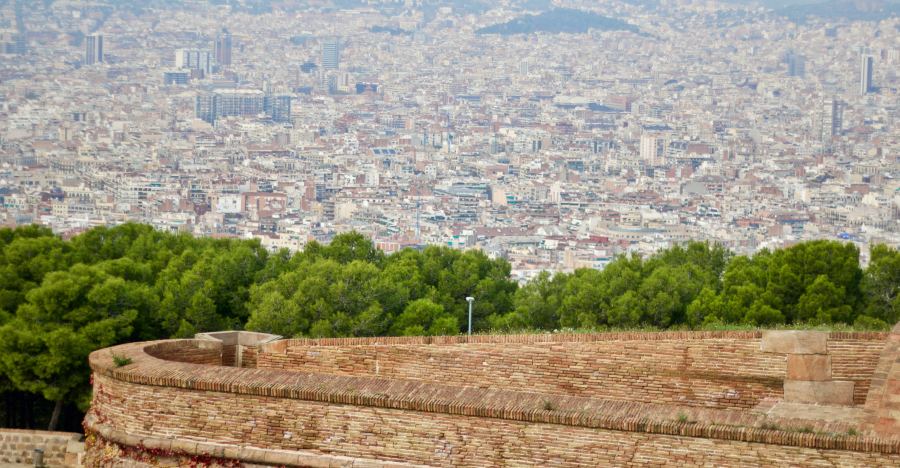
Transbordador Aeri del Port Cable Car
The cable car runs between the seaside and Montjuic Hill. The route is approximately 1.3 kilometers long, and the entire journey takes about 10 minutes. It offers a wonderful view along the way and is definitely worth the ride!
Public transport tickets are not valid!
Schedule and ticket prices can be found here!
Access: take bus V15 or V19 to the Pg Joan de Borbó – Pl del Mar stop.
Tibidabo
Rising 512 meters above the city, this hill offers the best view of Barcelona.
On the hill stands the Temple of the Sacred Heart of Jesus (Temple Expiatori del Sagrat Cor), which offers beautiful views from its top. The church’s crypt is also worth mentioning. Entry to the church and the crypt is free!
There is an amusement park (Parc d’Atraccions Tibidabo) here. While not modern, it is a great entertainment option for children. Opening hours and ticket purchases can be found on the official website.
The TV tower, Torre de Collserola, also functions as a lookout. You can go up to the 10th floor, making it the highest viewpoint in Barcelona. Opening hours and ticket prices can be found on the official website.
Access: summarized here along with ticket prices.
- Take the S1 or S2 train to the Peu del Funicular station, then take the Vallvidrera funicular, followed by bus 111. All are free with public transport tickets.
- Take the T2A bus (Tibibus) from Placa Catalunya. A separate ticket is required.
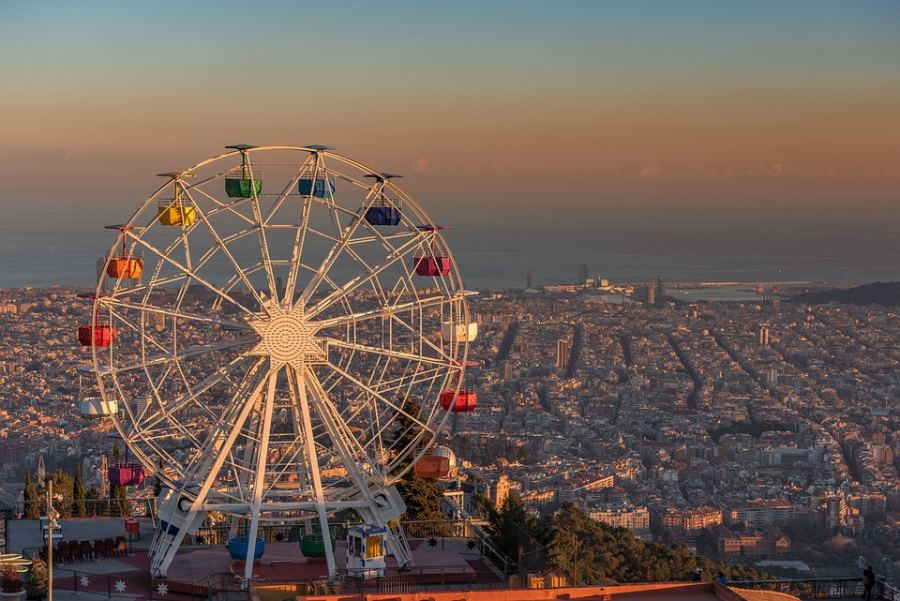
Barceloneta
The city’s beach is within easy walking distance from the city center.
The nearly 2 km long sandy beach is always filled with people relaxing, sunbathing, or engaging in sports. Along the promenade, there are many bars and restaurants.
Torre Bellesguard
Another Gaudi creation, less visited because it is not in the immediate city center.
The building was constructed on the ruins of a 15th-century castle once used by King Martin of Aragon. Inspired by the historic site, Gaudi designed it combining Gothic and Modernist elements. The building was constructed between 1900 and 1909.
The iconic tower, Torre Bellesguard, rises from one corner of the base, emphasizing the structure’s verticality with Gaudi’s straight, vertical lines.
The roof is itself a work of art, featuring characteristic Gaudi-style tiles and decorative elements, resembling a dragon. The view from here is also very beautiful.
It can be visited with a guide. All information is available on the official website!
Access: take bus 196 to the Bellesguard-Josep Canaleta stop.


